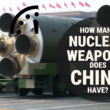No stability without limits on missile defense
By Wu Riqiang, September 24, 2014
Analysts have been discussing missile defense and its potential impact on strategic stability since the 1960s, and a basic insight that emerged decades ago still pertains today. If a nuclear-armed nation can develop a missile defense system capable of neutralizing a second nation's capacity for nuclear retaliation, the first nation's incentives for launching an initial strike will increase.
This would undermine strategic stability—so nuclear-armed states must refrain from building missile defense systems that cover their entire territories and populations. Indeed, the 1972 Anti-Ballistic Missile Treaty (ABM Treaty), a cornerstone of arms control during the Cold War, prohibited the deployment of antiballistic missile systems except around national capitals and around silo launchers for intercontinental ballistic missiles. Unfortunately, the United States withdrew from the ABM Treaty in 2002 and began to deploy a ballistic missile defense system in 2004. This has prompted serious concerns in China and Russia.
The concern springs not so much from the current US architecture for ballistic missile defense, which is small in scale and not very effective, but rather from what US missile defense might become. Today, the United States maintains 30 ground-based interceptor missiles in Alaska and California. This number is slated to increase to 44 by 2017, but even a system of that size will be incapable of neutralizing a Russian retaliatory attack. It will also be incapable of neutralizing China's nuclear deterrent. But that might change if the system displayed greater effectiveness—something the United States is working hard to achieve.
Discriminating between real warheads and decoys is the greatest challenge facing systems for midcourse missile defense. To address this challenge, the United States is deploying X-band radar in Japan and possibly in South Korea. It is constructing a new land-based X-band radar. It is developing a new "kill vehicle"—the segment of an interceptor that actually destroys a missile—that will be capable of transmitting photographs. This will help the United States implement a firing doctrine, known as shoot-look-shoot, which involves firing an interceptor, waiting to see if it has destroyed its target, and firing again if necessary. If the United States can improve its discrimination capabilities sufficiently through measures such as these, neutralizing China and Russia's nuclear deterrents will simply be a matter of deploying enough interceptors.
The United States maintains that its homeland ballistic missile defense system is intended only to guard against threats from North Korea and Iran, not from China or Russia. But if the system's purpose is really so limited, Washington should accept limits on its missile defenses. It refuses to do so. Russia has requested that the United States provide legal guarantees that its interceptors will not target Russia's strategic missiles. It has requested military-technical guarantees that a European-based missile defense system cannot neutralize Russia's strategic missiles. It has suggested that a system be established allowing NATO and Russia to exercise joint control over the launch of interceptors. The United States has resisted all these proposals, and it seems unlikely that Russia and the United States will reach a deal on missile defense in the near future. To Russia—and to China, for that matter—Washington's refusal to accept limits on its missile defense suggests that the system holds underlying potential to neutralize Russia and China's nuclear deterrents. It also suggests that the Obama administration wants to provide future administrations with the flexibility to harness this potential.
Contradictory policy. An open-ended US commitment to ballistic missile defense will hinder the global disarmament process and perhaps even trigger a renewed nuclear arms race. In particular it will be very difficult to persuade Russia, as long as the future of missile defense remains unpredictable, that strategic stability can be maintained with nuclear arsenals reduced to low levels. Moscow is already skeptical about nuclear reductions because of the US capability to launch precision conventional strikes, as well as Washington's commitment to qualitatively enhancing its offensive nuclear forces even as it quantitatively shrinks its arsenal.
From China's perspective, things look even worse. China's modest nuclear arsenal could be neutralized even by a small-scale US ballistic missile defense system—as long as the system were sufficiently effective. If China's leaders come to believe that the US missile defense system can neutralize Beijing's deterrent, they may well decide to construct more nuclear weapons to restore strategic stability. The result would be a defense-offense arms race.
The Obama administration is pursuing a contradictory nuclear policy. On one hand, the administration insists that it "will continue to reject any negotiated restraints on US ballistic missile defenses." On the other hand, it expresses a desire to maintain strategic stability with China and Russia, carry out further reductions in nuclear stockpiles, and work toward a world without nuclear weapons. The paradox is that Washington's refusal to accept limits on missile defense makes the administration's other goals unachievable. Maintaining strategic stability and making progress toward disarmament both require the United States to accept limits on its missile defenses—and also require it to demonstrate that its missile defenses are capable of countering threats only from North Korea and Iran—not from China and Russia.
Future arms control arrangements must include limits on missile defense. Given US concerns about missile threats from countries such as Iran and North Korea, it seems impractical simply to resuscitate the ABM Treaty and try to “uninvent” US homeland missile defense. But limits on strategic defensive capabilities must be embedded in any future agreements on strategic offensive weapons. If Russia and the United States negotiate further treaties to reduce nuclear arsenals, limits on missile defense must be an element. And if the United States expects China not to expand its nuclear arsenal, it must give China assurances that the effectiveness of its missile defense system will remain at a modest level—robust enough to counter the simple intercontinental ballistic missiles that North Korea or Iran might fire, but unable to contend with China’s sophisticated missiles. As a first step, the United States must express a political willingness to accept limits on missile defense. This is a precondition for any serious arms control dialogue going forward.
Topics: Nuclear Weapons
Share: [addthis tool="addthis_inline_share_toolbox"]














